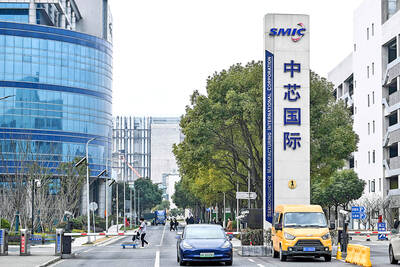Damage to its iPhone factory in the Indian state of Karnatakaia is much less than has been reported, Wistron Corp (緯創) said yesterday in a filing with the Taiwan Stock Exchange.
A “preliminary” assessment of the damage from Saturday’s riot was between NT$100 million and NT$200 million (US$3.51 million and US$7.03 million), not the NT$1.67 billion that the Times of India reported on Monday, the contract electronics manufacturer said.
“On the topic of the violent unrest at our Narasapura plant, we are doing our best to recover from and assess the damage. The main production equipment and warehouses have not been as seriously damaged as reported,” Wistron said.

Photo: AFP
“We are working with local police and talking with our insurers,” it said.
The company declined to provide further information beyond what it said in the filing.
Footage uploaded to Twitter shows people breaking windows and equipment at the new iPhone plant in the Narasapura industrial area in Karnataka, while the BBC reported that “hundreds” of people were involved.
While the Times of India on Sunday said that the rioters were employees angry over a wage dispute, Wistron on Monday said that they were “unknown individuals,” and reiterated its commitment to following local labor laws to “maximize the benefits to our workers.”
At the Legislative Yuan in Taipei yesterday, Minister of Economic Affairs Wang Mei-hua (王美花) told lawmakers that Taiwan’s economic representatives in India were in “intensive contact” with Wistron and would “extend support as needed by the company.”
Asked if the government would utilize a bilateral investment agreement (BIA) with India over the incident, she said that the agreement “does not apply.”
“This is an individual incident. We are not at a place where it is suitable to call upon the BIA,” Wang said.
The Indian government was “immediately responsive” to the incident, she said.
However, Chinese Nationalist Party (KMT) Legislator Wen Yu-hsia (溫玉霞) urged the government to “get tough.”
“We encouraged our people to invest in India. We have signed a BIA with India, and now this kind of thing happened,” Wen said. “The government needs to get tough and support Wistron in negotiations with the Indian government.”
Morgan Stanley analysts Howard Kao (高燕禾) and Sharon Shih (施曉娟) yesterday said that the impact on Wistron would be limited for the time being.
“However, we plan to monitor the situation closely — key factors will be the length of the production halt, possible changes in Wistron’s relationship with Apple after this incident, and the progress of Wistron’s phase 2 capacity expansion,” they wrote in a research note.
The plant had started production just a few months ago, with a capacity for just 5 million to 10 million iPhones per year, they said.
It is Wistron’s second production site in India and handles older phones, rather than the latest iPhone 12, they added.

NO BREAKTHROUGH? More substantial ‘deliverables,’ such as tariff reductions, would likely be saved for a meeting between Trump and Xi later this year, a trade expert said China launched two probes targeting the US semiconductor sector on Saturday ahead of talks between the two nations in Spain this week on trade, national security and the ownership of social media platform TikTok. China’s Ministry of Commerce announced an anti-dumping investigation into certain analog integrated circuits (ICs) imported from the US. The investigation is to target some commodity interface ICs and gate driver ICs, which are commonly made by US companies such as Texas Instruments Inc and ON Semiconductor Corp. The ministry also announced an anti-discrimination probe into US measures against China’s chip sector. US measures such as export curbs and tariffs

The US on Friday penalized two Chinese firms that acquired US chipmaking equipment for China’s top chipmaker, Semiconductor Manufacturing International Corp (SMIC, 中芯國際), including them among 32 entities that were added to the US Department of Commerce’s restricted trade list, a US government posting showed. Twenty-three of the 32 are in China. GMC Semiconductor Technology (Wuxi) Co (吉姆西半導體科技) and Jicun Semiconductor Technology (Shanghai) Co (吉存半導體科技) were placed on the list, formally known as the Entity List, for acquiring equipment for SMIC Northern Integrated Circuit Manufacturing (Beijing) Corp (中芯北方積體電路) and Semiconductor Manufacturing International (Beijing) Corp (中芯北京), the US Federal Register posting said. The

India’s ban of online money-based games could drive addicts to unregulated apps and offshore platforms that pose new financial and social risks, fantasy-sports gaming experts say. Indian Prime Minister Narendra Modi’s government banned real-money online games late last month, citing financial losses and addiction, leading to a shutdown of many apps offering paid fantasy cricket, rummy and poker games. “Many will move to offshore platforms, because of the addictive nature — they will find alternate means to get that dopamine hit,” said Viren Hemrajani, a Mumbai-based fantasy cricket analyst. “It [also] leads to fraud and scams, because everything is now

MORTGAGE WORRIES: About 34% of respondents to a survey said they would approach multiple lenders to pay for a home, while 29.2% said they would ask family for help New housing projects in Taiwan’s six special municipalities, as well as Hsinchu city and county, are projected to total NT$710.65 billion (US$23.61 billion) in the upcoming fall sales season, a record 30 percent decrease from a year earlier, as tighter mortgage rules prompt developers to pull back, property listing platform 591.com (591新建案) said yesterday. The number of projects has also fallen to 312, a more than 20 percent decrease year-on-year, underscoring weakening sentiment and momentum amid lingering policy and financing headwinds. New Taipei City and Taoyuan bucked the downturn in project value, while Taipei, Hsinchu city and county, Taichung, Tainan and Kaohsiung